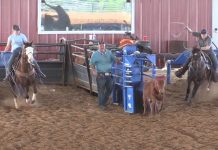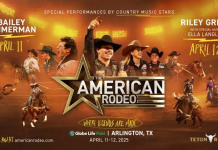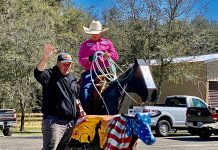Breaking it Down – September 2021
The other day my son asked me if I thought he should work more on his heading and whether he should head or heel. He is now a #7+ heeler and at times his fundamentals look very good.
Heeling is a hard thing to master because the equations change with every run. So much depends on who you’re heeling behind, the horse you’re heeling behind, what number is the roping you’re in, and how you approach the steer. There are so many equations that differ depending on what you’re trying to accomplish. It might be surprising to learn that my students normally consist of more heelers than headers.
To me roping is almost like a golf swing. If one thing gets out of line, it affects a number of things immediately after and causes a lot of problems. We first start a lesson by roping steers. First steer is a high teamer where you have to be 11 seconds or faster to win the roping. Then 9, 7, 5, and depending on the level of roper they may need to try and be 3. Then we go in and watch the video and look at how they leave the box and the position going down the arena. When you ride position to be 5 and you only have to be 11, then when the cow turns, you’re on top of the steer, then pulling on your horse and standing still, trying to heel the cow as he leaves you.
Position in heeling is the most common factor that heelers struggle with when they start trying to rope faster, all the way to #10 heelers. If you don’t ride good position going down the arena, it creates a lot of nightmares, like not being able to see the cow while you’re trying to heel him.
Gabe has five heel horses he rides regularly. Each horse has to be ridden differently. Shotgun is cowy and wants to be inside so he can ride tighter. The horse has a very short neck, so Gabe can see the feet from a lot of different places. One of the things we work on is remembering which horse he’s riding and how that affects his position going down the arena so he can get eyes on the steer’s feet as soon as possible.
Often the struggles a high number heeler has comes down to the position they’re riding. If you are a #9 or #10, you have enough ability with a rope to create shots. If you’re struggling, most of the time it comes down to position which causes a change in the swing and angle of your loop.
It can be very frustrating because one day you can rope really good and the next day can’t seem to catch one. There are several things we work on with Gabe. Keeping his horse soft in the corner and responding to his left hand. And as bad as he wants to, not heeling every steer on the first hop and keeping his horse moving through the corner. The last thing we work on is his dally. I told him I would always say he needs to learn to dally faster, from the time he holds his hand up until he wraps it around the saddle horn. That is one of our regular drills on the Speed Trainer. He throws his loop, pauses 3 seconds, holds his hand up, pauses 3 seconds, then he dallies as fast as possible while holding his left hand still without reining his horse out. This is very controlled on the Speed Trainer and if he does move that left hand, the buzzer will let him know.
So, back to the original question from my son – should he work on his heading or heeling? It is much more enjoyable, fun and challenging to heel in the practice pen. Heading and turning steers can be very boring in the practice pen unless you have a play toy head horse where you can work on going fast. That is a decision he has to make, whichever he enjoys most. When he gets to the Open level, I think we will have an in depth conversation.
What’s new with me: Lately I’ve had a lot of students book weeklong lessons. It’s more rewarding because they have time to implement changes and we’re able to see their accomplishments. I don’t teach many one day lessons because the video can be humiliating and confusing. Trying to change things is such a slow process unless you’re a high numbered roper. At that level it’s easier to make adjustments.
My greatest teaching tool is the video, it makes my life much easier and does not lie. When we play it in slow motion, it’s easier to see when your hands, feet and body are in the wrong place and the horse is being told all the wrong things to do at the wrong time. It takes a little bit to break those habits. I’m a believer in riding the horse correctly and not sacrificing horsemanship to catch every cow. Sometimes it’s necessary, but not every time you throw your rope. I’ve only had a few people who tried to argue with the video.
I feel very fortunate that both of my kids love to rope and I’m able to teach other people something I love to do.



